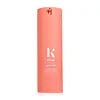What's inside
What's inside
 Key Ingredients
Key Ingredients

 Benefits
Benefits

 Concerns
Concerns

 Ingredients Side-by-side
Ingredients Side-by-side

Water
Skin Conditioning3-O-Ethyl Ascorbic Acid
Skin ConditioningBifida Ferment Lysate
Skin ConditioningCentella Asiatica Extract
CleansingNiacinamide
SmoothingCamellia Sinensis Leaf Extract
AntimicrobialPanthenol
Skin ConditioningGlycerin
HumectantAvena Sativa Kernel Flour
AbrasiveResveratrol
AntioxidantPhenoxyethanol
PreservativeButylene Glycol
HumectantPolyacrylate Crosspolymer-6
Emulsion StabilisingPropylene Glycol
HumectantSodium Polyglutamate
HumectantSodium Lauroyl Lactylate
EmulsifyingSodium Acetylated Hyaluronate
HumectantSodium Hyaluronate
HumectantChlorphenesin
AntimicrobialDiisopropyl Adipate
EmollientPropanediol
SolventGlycyrrhiza Glabra Root Extract
BleachingCarnosine
Skin ConditioningPalmitamide Mea
Quercetin
AntioxidantSodium Metabisulfite
AntioxidantSodium Diethylenetriamine Pentamethylene Phosphonate
Lecithin
EmollientCarbomer
Emulsion StabilisingCeramide NP
Skin ConditioningSodium Gluceptate
Sodium Lactate
BufferingAcrylic Acid/Acrylamidomethyl Propane Sulfonic Acid Copolymer
Sodium Benzoate
MaskingAcetic Acid
BufferingCeramide AP
Skin ConditioningCholesterol
EmollientPhytosphingosine
Skin ConditioningPolysorbate 20
EmulsifyingXanthan Gum
EmulsifyingDimethylmethoxy Chromanol
AntioxidantGlyceryl Caprylate
EmollientLactic Acid
BufferingEthylhexylglycerin
Skin ConditioningPalmitoyl Tripeptide-1
Skin ConditioningPalmitoyl Tetrapeptide-7
Skin ConditioningCeramide EOP
Skin ConditioningWater, 3-O-Ethyl Ascorbic Acid, Bifida Ferment Lysate, Centella Asiatica Extract, Niacinamide, Camellia Sinensis Leaf Extract, Panthenol, Glycerin, Avena Sativa Kernel Flour, Resveratrol, Phenoxyethanol, Butylene Glycol, Polyacrylate Crosspolymer-6, Propylene Glycol, Sodium Polyglutamate, Sodium Lauroyl Lactylate, Sodium Acetylated Hyaluronate, Sodium Hyaluronate, Chlorphenesin, Diisopropyl Adipate, Propanediol, Glycyrrhiza Glabra Root Extract, Carnosine, Palmitamide Mea, Quercetin, Sodium Metabisulfite, Sodium Diethylenetriamine Pentamethylene Phosphonate, Lecithin, Carbomer, Ceramide NP, Sodium Gluceptate, Sodium Lactate, Acrylic Acid/Acrylamidomethyl Propane Sulfonic Acid Copolymer, Sodium Benzoate, Acetic Acid, Ceramide AP, Cholesterol, Phytosphingosine, Polysorbate 20, Xanthan Gum, Dimethylmethoxy Chromanol, Glyceryl Caprylate, Lactic Acid, Ethylhexylglycerin, Palmitoyl Tripeptide-1, Palmitoyl Tetrapeptide-7, Ceramide EOP
Water
Skin ConditioningGlycerin
HumectantButylene Glycol
HumectantC15-19 Alkane
SolventSqualane
EmollientCellulose
AbsorbentC20-22 Alkyl Phosphate
EmulsifyingC20-22 Alcohols
Emulsion StabilisingPentylene Glycol
Skin Conditioning1,2-Hexanediol
Skin ConditioningCaprylyl Glycol
EmollientCarnosine
Skin ConditioningPolyacrylate Crosspolymer-6
Emulsion StabilisingMaltodextrin
AbsorbentXanthan Gum
EmulsifyingMannitol
HumectantXylitol
HumectantTocopherol
AntioxidantSalvia Miltiorrhiza Root Extract
Skin ConditioningRhamnose
HumectantBiosaccharide Gum-1
HumectantCitric Acid
BufferingGlycine Soja Oil
EmollientHydrolyzed Hyaluronic Acid
HumectantSodium Hydroxide
BufferingPalmitoyl Tetrapeptide-10
Skin ConditioningWater, Glycerin, Butylene Glycol, C15-19 Alkane, Squalane, Cellulose, C20-22 Alkyl Phosphate, C20-22 Alcohols, Pentylene Glycol, 1,2-Hexanediol, Caprylyl Glycol, Carnosine, Polyacrylate Crosspolymer-6, Maltodextrin, Xanthan Gum, Mannitol, Xylitol, Tocopherol, Salvia Miltiorrhiza Root Extract, Rhamnose, Biosaccharide Gum-1, Citric Acid, Glycine Soja Oil, Hydrolyzed Hyaluronic Acid, Sodium Hydroxide, Palmitoyl Tetrapeptide-10
 Reviews
Reviews

Ingredients Explained
These ingredients are found in both products.
Ingredients higher up in an ingredient list are typically present in a larger amount.
Butylene Glycol (or BG) is used within cosmetic products for a few different reasons:
Overall, Butylene Glycol is a safe and well-rounded ingredient that works well with other ingredients.
Though this ingredient works well with most skin types, some people with sensitive skin may experience a reaction such as allergic rashes, closed comedones, or itchiness.
Learn more about Butylene GlycolCarnosine is a dipeptide made from two amino acids.
This ingredient helps:
Glycation is the process of sugars binding to and damaging proteins. Too much sugar in our skin can lead to damaged collagen, contributing to factors of aging.
Carnosine is water-soluble and is not able to travel deeper layers of skin. This leads to some doubt about whether it can boost collagen in skin, since collagen is located in the deeper layers of skin.
Fun fact: Carnosine can be naturally found in our muscles and brain.
Learn more about CarnosineGlycerin is already naturally found in your skin. It helps moisturize and protect your skin.
A study from 2016 found glycerin to be more effective as a humectant than AHAs and hyaluronic acid.
As a humectant, it helps the skin stay hydrated by pulling moisture to your skin. The low molecular weight of glycerin allows it to pull moisture into the deeper layers of your skin.
Hydrated skin improves your skin barrier; Your skin barrier helps protect against irritants and bacteria.
Glycerin has also been found to have antimicrobial and antiviral properties. Due to these properties, glycerin is often used in wound and burn treatments.
In cosmetics, glycerin is usually derived from plants such as soybean or palm. However, it can also be sourced from animals, such as tallow or animal fat.
This ingredient is organic, colorless, odorless, and non-toxic.
Glycerin is the name for this ingredient in American English. British English uses Glycerol/Glycerine.
Learn more about GlycerinPolyacrylate Crosspolymer-6 is a texture enhancer and pH adjuster.
It is be used to thicken water-based products and create a gel-texture with a velvet feel.
One manufacturer claims this ingredient to have a pH range of 2-8 and to be biodegradable.
Learn more about Polyacrylate Crosspolymer-6Water. It's the most common cosmetic ingredient of all. You'll usually see it at the top of ingredient lists, meaning that it makes up the largest part of the product.
So why is it so popular? Water most often acts as a solvent - this means that it helps dissolve other ingredients into the formulation.
You'll also recognize water as that liquid we all need to stay alive. If you see this, drink a glass of water. Stay hydrated!
Learn more about WaterXanthan gum is used as a stabilizer and thickener within cosmetic products. It helps give products a sticky, thick feeling - preventing them from being too runny.
On the technical side of things, xanthan gum is a polysaccharide - a combination consisting of multiple sugar molecules bonded together.
Xanthan gum is a pretty common and great ingredient. It is a natural, non-toxic, non-irritating ingredient that is also commonly used in food products.
Learn more about Xanthan Gum